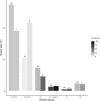Achievement of appropriate cesarean rates using Robson's 10-Group classification system in Brazilian private practice
- PMID: 37430192
- PMCID: PMC10332037
- DOI: 10.1186/s12884-023-05803-2
Achievement of appropriate cesarean rates using Robson's 10-Group classification system in Brazilian private practice
Abstract
Background: Increasing cesarean section (CS) rates are a global concern because they are related to higher maternal and neonatal complication rates and do not provide positive childbirth experiences. In 2019, Brazil ranked second globally, given its overall CS rate of 57%. According to the World Health Organization (WHO), populational CS rates of 10-15% are associated with decreased maternal, neonatal, and infant mortality rates. This study aimed to investigate whether multidisciplinary care following evidence-based protocols associated with a high motivation of both women and professionals for a vaginal birth leads to less overuse of CS in a Brazilian private practice (PP).
Methods: This cross-sectional study evaluated CS rates by Robson group for women who sought vaginal birth in a private practice in Brazil comparing with Swedish data. Collaborative care of midwives and obstetricians who adopted evidence-based guidelines was offered. CS rates, overall and by Robson group, contribution of each Robson group to the overall CS rate, clinical and nonclinical interventions, vaginal birth, pre-labor CS, and intrapartum CS proportions were estimated. The expected CS rate was calculated using the World Health Organization C-model tool. The analysis used Microsoft Excel and R Studio (version 1.2.1335. 2009-2019).
Results: The PP overall CS rate was 15.1% (95%CI, 13.4-17.1%) versus the 19.8% (95%CI, 14.8-24.7%) rate expected by the WHO C-model tool. The population included 43.7% women in Robson Group 1 (nulliparous, single, cephalic, at term, spontaneous labor), 11.4% in Group 2 (nulliparous, single, cephalic, at term, induced labor or CS before labor), and 14.9% in Group 5 (multiparous women with previous CS), the greatest contributors to higher CS rates (75.4% of them). The Swedish overall CS rate was 17.9% (95%CI, 17.6-18.1%) in a population of 27% women in Robson Group 1, 10.7% in Group 2, and 9.2% in Group 5.
Conclusions: Multidisciplinary care following evidence-based protocols, associated with high motivation of both women and professionals for vaginal birth, may lead to a significant and safe reduction of CS rates even in contexts such as Brazil, with high medicalization of obstetric care and excess CS.
Keywords: Cesarean section rates; Health Care Models; Humanized childbirth; Patient-centered care, evidence-based practice; Robson classification.; Supplementary health.
© 2023. The Author(s).
Conflict of interest statement
The authors declare no competing interests.
Figures


References
-
- WHO - World Health Organization. Robson classification: implementation manual. 2017 https://apps.who.int/iris/handle/10665/259512 (accessed Aug 29, 2021).
-
- Robson MS. Classification of caesarean sections. Fetal Matern Med Rev. 2001;12:23–39. doi: 10.1017/S0965539501000122. - DOI
-
- WHO - World Health Organization, RHR - Department of Reproductive Health and Research. WHO Statement on Caesarean Section Rates. Geneva, 2015 https://apps.who.int/iris/bitstream/handle/10665/161442/WHO_RHR_15.02_en... (accessed Nov 18, 2021).
-
- DASNT - Departamento de Análise em Saúde e Vigilância das Doenças Não Transmissíveis. Painel de Monitoramento de Nascidos Vivos. 2021. http://svs.aids.gov.br/dantps/centrais-de-conteudos/paineis-de-monitoram....
MeSH terms
LinkOut - more resources
Full Text Sources
Medical
Miscellaneous

